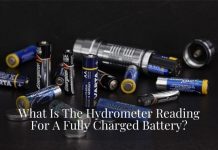
When it comes to button-type batteries used to power small and portable devices, it never fails to raise a few confusions and misconceptions, here and there. Like any other coin cell battery, the AG13 and A76 coin-type batteries are one of those power cells that get a lot of people confused and create misconceptions that trigger debates among battery experts, opinionated people, and self-proclaimed experts.
In most cases, it starts with a substantial yet straightforward question that usually posted on social media platforms, then an eager and serious person will answer as a comment. From there, a flood of comments begins, and contradicting claims and arguments heat up, making them viral.
Are AG13 and A76 batteries the same? This is a perfect example of a question about coin-type batteries that raises misconceptions and gets people confused. Anyway, a logical answer to the question is YES, AG13, and A76 cells are actually the same, and the “AG13” or “A76” are just labels used to refer to a coin-type battery commonly used to power wristwatches.
According to IEC or International Electrotechnical Commission, this battery has a standard designation code of 1154 or 44. This battery comes in two variations, depending on the chemistry they feature. There’s the alkaline chemistry that has a standard label of LR1154 or LR44 and the silver oxide chemistry known for its standard label that reads SR1154 or SR44.
What makes this matter confusing is that, aside from the usual name for the battery, which is two for the alkaline type and another two for the silver oxide type, battery manufacturers also use their own and preferred name or label for the same power cell. This gives one battery plenty of names causing people to get confused and assume a lot of things.
So, basically, AG13 and A76 are among the labels that refer to the standard 1154 or 44 battery that also comes in two different battery chemistry with two different standard names or labels.
On that note, this will lead us to a conclusive yet a bit confusing answer that AG13 and A76 refer to one battery that can have an alkaline or silver oxide chemistry. This means that an AG13 alkaline coin cell battery can also be applied to as A76 cell with alkaline chemistry. The same goes for the silver oxide type.
If you are reading this article, you are a high chance that you are confused about AG13 or A76 batteries. Looking for an answer and a credible and reliable source to confirm that AG13 and A76 are the same. If so, you already got an answer just a while ago.
But in case you are in doubt and you still feel unsatisfied, you can stick around and read on to learn more. I’ll help you clear your mind and get rid of your doubts with verified facts about the battery that stirs your mind. Come, and let’s start digging deeper.
Truth About the 1154 or 44 Battery Labeled as AG13 and A76
To shed some light on this aspect or matter regarding the AG13 or A76 battery. You must first understand that there’s a commission in charge of officially naming these coin cell batteries. It is the International Electrotechnical Commission (IEC), the sanctioned authority that provides the accepted names of these kinds of batteries.
And on that note, IEC has named the AG13 or A76 battery as LR1154 or LR44 if it has alkaline chemistry and SR1154 or SR44 if it has the silver oxide chemistry. So, to establish a common ground for this article, we refer to this battery as “1154” or “44” cells regardless of the battery chemistry.
Now to get back to the main issue. IEC has two standard labels for the 1154 or 44 battery with prefixes that determines the chemistry it has, which is a good thing. However, the confusion about this battery starts with the manufacturers.
This is because the IEC gave them the freedom to name each and every cell they produce, leading to one battery model to have multiple labels and names. This is where the debates, confusions, and misconceptions began. To understand this aspect better, let us have an example simulating the described situation.
Let’s take the 1154 or 44 battery, a coin-type power cell that has a voltage rating of 1.5 volts, termination voltage rated at 0.9 volts, and capacity rated at 130 mAh. Now, this battery supposes to have a standard label of LR1154 or LR44 if it is an alkaline cell and SR1154 or SR44 if it is a silver oxide cell.
Here’s where the manufacturers come in. Let’s say there are three companies that produce this 1154 or 44 battery, namely; A, B, and C. All of them manufacture an alkaline and silver oxide 1154 (44) power cell with the same size, voltage rating, and capacity.
Company A names its models A1154 or A44 for the alkaline type and AS1154 or AS44 for the silver oxide type. Then company B names its versions as B1154 or B44 and BS1154 or B44, respectively.
And then company C wanted a different approach, naming its versions as AL24 (alkaline) and SO24 (silver oxide). That gives 1154 (44) battery three various labels for each type, not including the official name.
This example clearly shows why a lot of people are confused about this kind of battery or other electronic products. It leads to questions like the one we are trying to answer in this article.
So, to be clear, AG13 and A76 are labeling for coin-type battery with a standard name or label LR1154 or LR44 for the alkaline type and SR1154 or SR44 for the silver oxide type. Other labels for this battery also include 303 and 357.
I hope that this cleared out the confusion about the AG13 or A76 coin cell battery. So, before we proceed and to avoid further uncertainty, let us refer to it as 1154 or 44 for now. That will help us remove any other complications since there are plenty of chemistries involved later.
The Full Battery Specification of the AG13 or A76 Battery
1154 or 44 coin cell batteries usually come in a variety of chemistry, and each of them has slightly different specifications. What is the same to all of them is the size of the battery with a diameter measured at 11.6 mm and height measured at 5.4 mm.
For the voltage rating and battery capacity of the 1154 or 44 battery, they vary according to the chemistry the battery has.
Before we go to the more detailed part of the specifications of the 1154 or 44 batteries, you have to be familiar with the prefixes used for the battery first.
Below is a list of the designations used to label the cell that indicates the chemistry it has.
● “L” – Battery label that starts with this letter indicates an alkaline chemistry
● “S” – Battery label that starts with this letter indicates a silver oxide chemistry
● “P” – Battery label that starts with this letter indicates a zinc oxide chemistry
● “M or N” – Battery label that starts with this letter indicates a mercury oxide chemistry, however, due to dangers mercury presents this kind of battery is no longer produced
Apart from those prefixes that indicate the chemistry of the cell, that is found at the start of the code, before the digits. You also have to understand that there are also the prefixes added on the battery labels after the digits, and they indicate the electrolyte used by the battery.
If there’s a letter “P” at the end of the code, it means that it has a potassium hydroxide as its electrolyte. If there’s the letter “S” after the digits, that indicates a sodium hydroxide battery electrolyte. In case the battery label does not have any letters (P or S) after the numbers, that means the battery uses an organic electrolyte.
Finally, if the battery label has the letter “W” after the digits, that means that it is a battery that complies with the 60086-3 watch battery standards of the IEC.
Full Specifications of the Different Chemistries of the 1154 or 44 Cells
Here’s the cheesy part, where you are going to discover the voltage ratings and capacities of the different chemistries of the 1154 battery. As I mentioned above, there are four battery chemistries used in manufacturing the said power cell, and they offer different performance due to the different materials used.
Check out the list below to learn more about the details of each battery chemistry.
1. Alkaline Battery Chemistry
As I mentioned earlier, the prefix “L” indicates alkaline battery chemistry, making the label of LR1154 or LR44. This alkaline coin-type battery has a nominal voltage rated at 1.5 volts, and its cut-off voltage is rated at 1.0 volt. The LR1154 battery has a capacity within the range of 110 mAh to 130 mAh.
2. Silver Oxide Battery Chemistry
The battery that features the silver oxide chemistry has a prefix “S” at the beginning of the label. So, this battery is coded as SR1154 or SR44, and it has a capacity ranging from 150 mAh to 200 mAh.
This silver oxide coin-type battery has a nominal voltage rating of 1.55 volts and a cut-off voltage rated at 1.2 volts. Due to its more stable chemical structure, this battery delivers constant voltage without dropping, making it a more desirable cell.
3. Zinc-Air Battery Chemistry
Zinc-air chemistry is indicated by the letter “P” in the label of the battery, before the digits, giving this battery a name of PR1154 or PR44. This zinc-air coin-type battery has a nominal voltage rated at 1.4 volts, and its cut-off voltage is rated at 1.2 volts.
The capacity of this power cell is within the range of 600 mAh to 700 mAh. Having a larger capability to store more charge and lower voltage to deliver, this kind of battery is mostly used in hearing aids.
4. Mercury Oxide Battery Chemistry
Although this battery chemistry is no longer manufactured, it is best to see still the specs it has to offer for better awareness.
Indicated by the prefix “M or N,” this battery is labeled as MR1154 or MR44, and it was supposed to have a capacity in the range of 180 mAh to 200 mAh. The nominal voltage of the battery is rated at 1.35 volts, with a cut-off voltage rated at 1.1 volts.
Final Thoughts
Thank you for taking the time to read this article, and I hope that you find it helpful and cleared some of the things that got you confused. To refresh your memory, AG13 and A76 are labels used to refer to one battery, and therefore, they are the same.
The standard label for the battery that these labels refer to is LR1154 or SR1154, depending on the chemistry it has.





